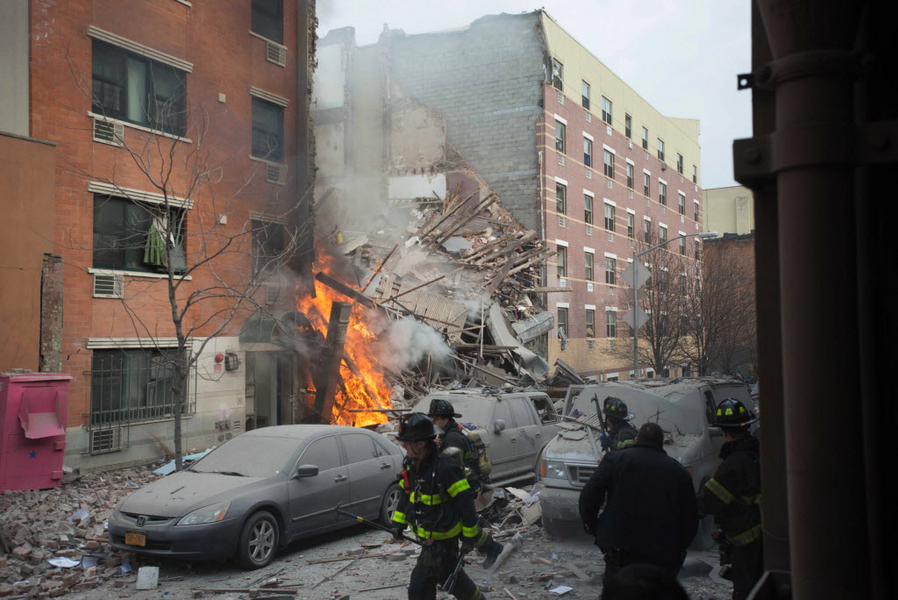Deadly building explosion puts focus on NYC's aging infrastructure
Loading...
| New York
The deadly explosion and collapse of two Harlem tenements early Wednesday – “a tragedy of the worst kind,” said New York Mayor Bill de Blasio – and the likelihood that a gas leak was to blame have officials and advocacy groups turning their attention to the city’s aging infrastructure.
The investigation into the exact cause of the suspected gas leak and explosion, which killed two people and injured more than 20, may take weeks, officials say.
But the five-story tenements that were reduced to rubble in the blast were among thousands of classic New York prewar structures that continue to house hundreds of thousands of city residents. The tenements included a store-front Spanish Christian Church sanctuary and the shops of a specialty piano-repair business.
There is a “dire need” for improvements to the city’s infrastructure, Ydanis Rodriguez, chair of the New York City Council’s transportation committee, said Wednesday afternoon, and the day’s events “demonstrate how real that need is.”
At 9:13 Wednesday morning, Con Edison received calls complaining of a gas odor, according to a spokeswoman for the utility, which supplies gas to Manhattan, the Bronx, and parts of northern Queens. A crew was dispatched immediately, the company said, and was en route when the buildings exploded.
Residents also had reported smelling gas the day before – even though a pipe had recently been replaced, the pastor of the store-front church told CBS news.
As of Wednesday afternoon, city officials confirmed that two women were killed and 22 people injured by the blast, which took place in a bustling residential and retail area near a major transportation hub that includes subway stops and a Metro North commuter rail station, where Amtrak also stops.
“This is a tragedy of the worst kind because there was no indication in time to save people,” said Mayor de Blasio at a news conference Wednesday afternoon. The search for more than a dozen missing people “will take quite a bit of time,” he said.
Debris from the blasts covered the elevated commuter tracks, shutting down the nation’s second-busiest system.
“With two reported deaths and over a dozen injuries, the human cost of inaction is clear,” said Councilman Rodriguez, a Manhattan Democrat. “If the necessary funding for these repairs and improvements is not granted by the federal and state governments, tragic occurrences such as today’s may become more common in our city.”
The transportation chair cited a report – released only the day before the explosion – by the Center for an Urban Future, a New York City-based think tank focused on the challenges facing New York and other cities.
According to the study, titled, “Caution Ahead: Overdue Investments For New York’s Aging Infrastructure,” the city’s staggering 6,300 miles of gas mains are 56 years old, and 60 percent of these are made of unprotected steel or cast iron – which are no longer used for modern gas lines since they are prone to cracks and subsequent leaks.
Con Ed has lost more than 2 percent of the gas it pumps to customers because of these system-wide leaks, the report says.
“Simply put, too much of the city’s essential infrastructure remains stuck in the 20th Century – a problem for a city positioning itself to compete with other global cities in today’s 21st Century economy,” the report also notes.
Other cities may face similar challenges with their aging infrastructure. In January, a coalition of researchers from Stanford, Duke, and Boston University mapped out almost 6,000 places in Washington, D.C., where the city’s buried gas mains were leaking enough methane to detect it from the street.
In 2012, many of the same researchers found more than 3300 leaks in Boston in which the amount of gas in the air was 15 times higher than the global background level.
According to the Center for an Urban Future report, New York City will have to spend about $47 billion to maintain or replace much of its infrastructure – including its water mains, transportation lines, and public buildings.
Rodriguez said he would work with de Blasio and Council Speaker Melissa Mark-Viverito, who represents East Harlem, where the explosion occurred, “to push for more funding for our transportation infrastructure and will look to hold a hearing on the troubling reports from the Center for an Urban Future to see what more we can do as a city to make our future more secure.”
For the past few years, New York City has already been requiring older buildings, most using heavy oil-burning boilers and heaters, to switch to cleaner burning natural gas. In April of 2011, the city’s Department of Environmental Protection began to phase out the use of certain polluting oil furnaces.
Since then, nearly 2,400 New York City buildings have switched to gas or other cleaner-burning fuels – and by 2030, all buildings must make the switch. Anticipating such growth, Con Edison says it plans to invest $1.73 billion on gas infrastructure over the next three years.








